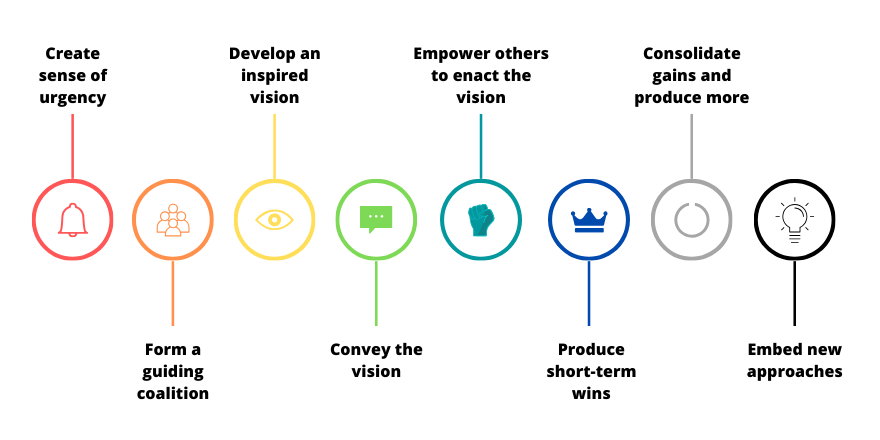Stephen Smith looks at what needs to be considered for a communications plan for returning to work, and looks at the Kotter model for organisational change. At the bottom of this article you can find a comms plan template to download.
Across the world coronavirus (COVID-19) lockdown measures are easing – and for many businesses and organisations the focus now is developing strategies on how employees can return to work safely.
Communication is one of the most important aspects of a return to work strategy. All return to work strategies should include a comms plan which establishes key messages, who needs to be contacted, who will be making contact and how messages will be delivered.
The PIPR (Prepare, Inform, Prevent and Recover) strategy separates the challenges of return to work strategies into 4 manageable chunks. The Inform stage of PIPR highlights the importance of communicating key messages related to workplace distancing, use of public transport and other workplace arrangements when developing a return to work employee plan.
The government has advised that if possible, those who can work from home should continue to do so. When lockdown measures were first introduced many employees, who did not normally work at home, started to – and in cases where this is to continue employers should ensure communication-related to this is shared in the right ways.
Those unable to return to work
Although many are now returning to work, many businesses and organisations are still unable to return employees to work. Those who are furloughed and unable to work may feel 'out of the loop' and forgotten if they do not receive updates or the same communication as employees able to return to work.
Employers also need to consider that this group of employees may not have access to communication channels they use when working. Comms messages may have to be adapted so they can be shared with non-working employees via personal devices and platforms.
Employee anxieties
Those returning to work after any period of absence are likely to feel anxious, and for many this is especially true in the current health crisis caused by the coronavirus (COVID-19) pandemic. As well as working lives being affected, the virus has significantly changed the way we live and the support systems we may have relied on previously.
Employers should consider the messages anxious employees require and the format in which this communication should be shared. Employees who may be suffering from mental health issues as a result of coronavirus (COVID-19) may not feel able to share this with line managers or the organisation, and therefore – businesses and organisations may need to ensure these messages are shared with all employees.
Kotter's 8-Step Change Model
There is a further argument that to ensure behavioural outcomes that maintain social and physical distancing measures and reduce the risk of infection, organisations and businesses need to implement a transformation strategy.
John Kotter, a thought leader in the field of business, developed an 8-Step Change Model which he recommends for leaders looking to introduce lasting transformations within an organisation. When creating this model, Kotter researched businesses which had tried to introduce transformations – and found that there was only a 30% chance of change initiatives being successful. This led him to create a framework which organisations can follow when implementing significant changes.
We think this model could be effective for businesses introducing coronavirus (COVID-19) measures and creating comms plans for how to share changes with employees.
1. Create a sense of urgency
There needs to be a sense of urgency when changes are introduced. Without urgency a transformation may be slow to start – something which cannot happen when it comes to coronavirus safety and social distancing measures.
Take-up needs to be effective as soon as possible to ensure employees can work safely.
Return to work comms plans should ensure that initial messaging focuses on the urgency of coronavirus (COVID-19) safety and social distancing measures, and why they need to be implemented and adhered to as quickly as possible.
To create a sense of urgency, messages should include how the virus has impacted the business or organisation, and how implementing new working practices and safety measures will help that business return and continue. Leaders should encourage dialogue during this stage, as those who receive the messages may identify additional solutions or potential threats within planned changes.
2. Form a guiding coalition
Change initiatives are projects and therefore require a project delivery team. Leaders within businesses and organisations should create a group of volunteers who are on-board with planned changes and understand overall objectives. This project team should be provided with the ability to manage the transformation and how the messages are shared within the organisation.
It is advised that project teams include individuals from different employee groups throughout the organisation as diversity is important in ensuring that comms are assessed from an employee's point of view. In addition to this, employees being aware that the project team includes those from all-levels can make comms and planned coronavirus safety measures more engaging, and make dialogue and open discussions feel more accessible to all.
3. Develop an inspired vision
Leaders and the transformation project team should create an 'inspiring vision for change' which can be shared within an organisation in messaging so that everyone understands the aims and objectives of the changes being introduced.
For those creating comms plans for coronavirus (COVID-19) return to work strategies, this stage should focus on ensuring the overall aims of new safety measures and social distancing practices and the timeframes involved are communicated effectively. It is important that comms relay to employees that lockdown measures are fluid and determined by infection rates. They may change, and although timeframes are important, safety measures, working practices and guidelines will be reviewed continually and their effectiveness monitored.
It is recommended that comms for this stage of the plan are shared in writing. Written comms, whether that be physical letters or emails, are preferred because recipients can take the time to read through messages and plans in their own time. This helps to ensure messages are not misheard and that values and strategies can be referred back to.
4. Convey the vision
The goal of any transformation project is to encourage cooperation and support for the vision and objectives of the project. This is why the way this is communicated within an organisation is so important. Leaders should make time to discuss the planned changes with individuals within a business or organisation at all levels. Open dialogue and feedback will provide leaders with the chance to address concerns and issues promptly – and this might include adding new messaging to comms plans.
This is especially important in organisations that feature different employee groups returning to work in different ways. For example, if a team is split by those who continue to work at home and those who are required to return to workplaces, each group may have very different concerns about planned coronavirus (COVID-19) safety measures.
Coronavirus (COVID-19) social distancing will likely prevent feedback group sessions and may make face-to-face meetings difficult. Instead, leaders should consider whether video call services such as Skype and Zoom can be used to host feedback sessions with employees.
5. Empower others to enact the vision
For change to take place, employees must have the right skills and resources and the confidence to implement them. This is especially true when it comes to coronavirus (COVID-19) safety measures. Leaders need to ensure that expected changes are accompanied with the right resources and training so that employees feel confident enough to follow new practices correctly. Without this, employees may resist change or feel unable to follow the measures required.
Businesses and organisations should consider whether e-learning can be used to quickly deliver training and return to work information to a large number of employees, who may be working at home and based at numerous locations.
E-learning can be sent to employees via email and the completion of courses can often be monitored so that leaders can assess when employees are ready to return to workplaces.
At this stage it is important that comms include information about the resources, training and other support systems which will be in place. This can help to reduce transformation anxiety and help to remove any obstacles to progressing changes.
6. Produce short-term wins
Achieving and communicating short-term goals can help to inspire employees to continue with required actions. Businesses and organisations should review the goals which are important when it comes to coronavirus (COVID-19) safety measures and how this can be shared throughout an organisation.
For example, one goal may be preventing new coronavirus (COVID-19) illnesses within the workforce. If changes are helping to support this, leaders may consider sending out anonymised workforce infection rates in weekly comms as a way of keeping individuals motivated and supportive of social distancing and safety measures.
At the same time, the impact of negative news should also be considered. If infection rates increase or safety measures are deemed to be ineffective, a comms plan should include a process and messages which would then need to be shared with employees.
7. Consolidate gains made and produce more
Change requires momentum, and maintaining this momentum is critical to ensuring a transformation is completed. Failure can result if victory is celebrated too early, momentum is lost or individuals feel changes are no longer important.
Employers must maintain support for coronavirus (COVID-19) social distancing and safety measures for them to continue to be effective. Employees must be congratulated for their participation in changes but must also understand that these changes are on-going and may evolve as and when lockdown measures do.
Comms plans for this stage should include continuing to let employees know that open dialogue is encouraged and that changes are subject to assessment. In addition to success, comms messaging should also include acknowledgement of failure and the measures put in place to address failures and prevent them from happening in the future.
8. Embed new approaches
The final step of this model is to embed changes within the core values and culture of a business or organisation. Change does not sustain itself and all existing and future processes, systems and working practices will need to consider what has been achieved.
The pandemic is here to stay for now, but in future, the way we contain and combat a virus may be different. This means the changes put in place to prevent the spread of infection may ease and organisations may be able to return to previous ways of working.
To ensure everyone is informed within a business and organisation its important that comms about changes do not just abruptly stop and this is especially true for changes related to coronavirus. Any changes to practices or government advice should be considered and communicated to all employees to ensure consistency and support for safety and social distancing measures.
Return to Work Comms Plan Template
To help make the planning of return to work employee messaging easier we have created a free comms template.
This template is a simple table, which features columns employers can use to develop employee messaging and considers the following:
- Target audiences
- Key messages
- Objectives
- Delivery methods
- Timings and status
A comms plan is not just a content calendar – it is a planning sheet, which identifies the key objectives of each message created. This helps to ensure that employee audiences and groups within a business receive the messages they require to implement coronavirus (COVID-19) safety and social distancing measures effectively.
CLICK HERE TO DOWNLOAD THE RTW COMMS TEMPLATE



